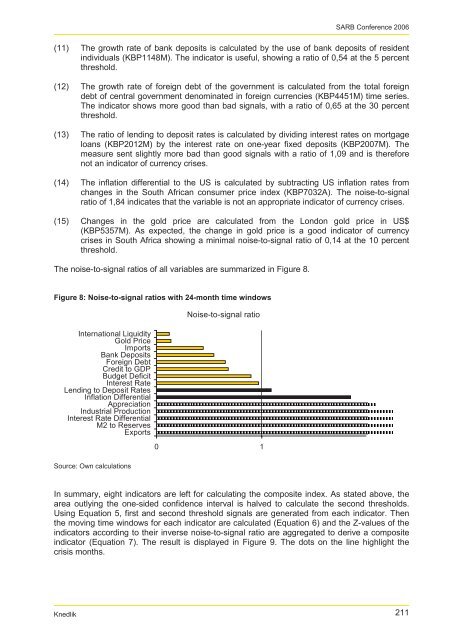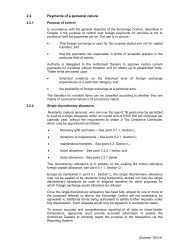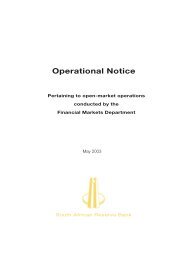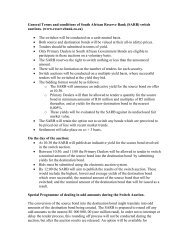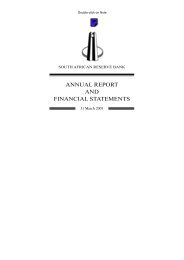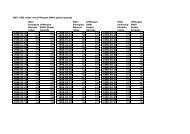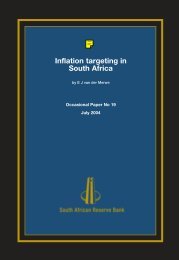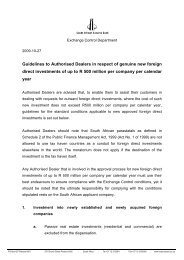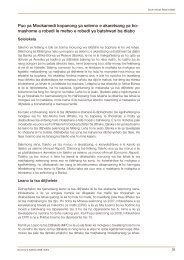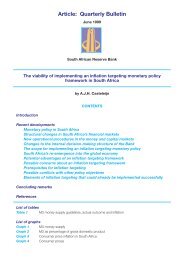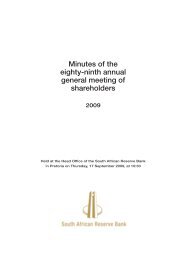SARB Conference 2006are not applicable, monthly time series are constructed by averag<strong>in</strong>g weekly data or by<strong>in</strong>terpolat<strong>in</strong>g mov<strong>in</strong>g averages from quarterly data. All data are sign-adjusted <strong>in</strong> order togenerate time series <strong>in</strong>dicat<strong>in</strong>g <strong>in</strong>creas<strong>in</strong>g pressure when their value rises. Data sources arepredom<strong>in</strong>antly the SARB or the Federal <strong>Reserve</strong> and Bureau of Labor Statistics <strong>in</strong> the US. A 24-month crisis w<strong>in</strong>dow is chosen <strong>in</strong> the analysis and an 18-months crisis w<strong>in</strong>dow is used to test forthe robustness of the result. Data up to August 2004 are used for the calculation of the noise-tosignalratio, s<strong>in</strong>ce it is unknown whether the time after that date may be followed by a crisis or not.The data sources of the set of variables used <strong>in</strong> signal<strong>in</strong>g <strong>currency</strong> <strong>crises</strong>, can be expla<strong>in</strong>ed asfollows:(1) As <strong>in</strong>dustrial production variable, the growth rate of gross value added at basic prices ofthe secondary sector (KBP6633D) is used and monthly data are generated by<strong>in</strong>terpolation. The measure shows a m<strong>in</strong>imal noise-to-signal ratio at a threshold of 25percent, which takes a value of 2,32. Thus, <strong>in</strong>dustrial production sends more falsealarms than good signals and is not considered <strong>in</strong> the composite <strong>in</strong>dex.(2) The ratio of budget deficits to GDP (KBP4420K) is constructed by <strong>in</strong>terpolation fromquarterly data and a calculation of the annual change. The <strong>in</strong>dicator shows more goodthan false signals; the noise-to-signal ratio is 0,90.(3) The appreciation of the real exchange rate is measured as an annual change <strong>in</strong> the realeffective exchange rate of the rand consistently, exclud<strong>in</strong>g Zimbabwe (KBP5367M). Themeasure shows the lowest noise-to-signal ratio at the 30 percent threshold and takes avalue of 2,08, which signifies that the measure is not a useful <strong>in</strong>dicator.(4) The change <strong>in</strong> the <strong>in</strong>ternational liquidity position (KBP5339M) is a good <strong>in</strong>dicator with am<strong>in</strong>imal noise-to-signal ratio of 0,12 at the 5 percent threshold.(5) The growth rate of merchandise exports (KBP5000K) is calculated by <strong>in</strong>terpolation fromquarterly data and sends just one good signal at the 30 percent threshold. The noise-tosignalratio of 36,0 is out of reach for use as <strong>in</strong>dicator. It was expected that fall<strong>in</strong>gexports would <strong>in</strong>crease the probability of a crisis, as <strong>in</strong>vestors may expect problems <strong>in</strong>servic<strong>in</strong>g foreign debt if exports earn<strong>in</strong>gs shr<strong>in</strong>k and withdraw.(6) Also, the growth rate of merchandise imports (KBP5003K) is calculated by <strong>in</strong>terpolationfrom monthly data. At a 25 percent threshold the noise-to-signal ratio is 0,44, show<strong>in</strong>gthat ris<strong>in</strong>g imports are a good <strong>in</strong>dicator of <strong>currency</strong> <strong>crises</strong> <strong>in</strong> <strong>South</strong> <strong>Africa</strong>.(7) The growth rate of the ratio of domestic credit to GDP is calculated from credit extension(KBP1368M) and <strong>in</strong>terpolated GDP (KBP6006K) figures. The m<strong>in</strong>imal noise-to-signalratio of 0,68, at a threshold of 30 percent, shows that the variable is a good <strong>in</strong>dicator of<strong>currency</strong> <strong>crises</strong>.(8) The growth rate of the ratio of M2 to <strong>currency</strong> reserves is calculated from M2(KBP1373M), gold and other foreign reserves (KBP5806M), and the US$ exchange rate(KBP5339M). The m<strong>in</strong>imal noise-to-signal ratio of 2,77 shows this not to be a useful<strong>in</strong>dicator.(9) The change <strong>in</strong> the domestic <strong>in</strong>terest rate is calculated by subtract<strong>in</strong>g the <strong>in</strong>flation rate(KBP7032A) from the <strong>in</strong>terpolated discount rate on 91-day Treasury bills (KBP1405W).The <strong>in</strong>dicator produces more good than bad signals; the ratio is 0,97 at a threshold of 10percent.(10) The <strong>in</strong>terest rate differential to the US is calculated be subtract<strong>in</strong>g the <strong>in</strong>flation correcteddiscount rate on 3-month US Treasury bills from the domestic <strong>in</strong>terest rate. The variabledoes not <strong>in</strong>dicate <strong>currency</strong> <strong>crises</strong> properly; the noise-to-signal ratio is 2,63 at the 30percent threshold.210Knedlik
SARB Conference 2006(11) The growth rate of bank deposits is calculated by the use of bank deposits of resident<strong>in</strong>dividuals (KBP1148M). The <strong>in</strong>dicator is useful, show<strong>in</strong>g a ratio of 0,54 at the 5 percentthreshold.(12) The growth rate of foreign debt of the government is calculated from the total foreigndebt of central government denom<strong>in</strong>ated <strong>in</strong> foreign currencies (KBP4451M) time series.The <strong>in</strong>dicator shows more good than bad signals, with a ratio of 0,65 at the 30 percentthreshold.(13) The ratio of lend<strong>in</strong>g to deposit rates is calculated by divid<strong>in</strong>g <strong>in</strong>terest rates on mortgageloans (KBP2012M) by the <strong>in</strong>terest rate on one-year fixed deposits (KBP2007M). Themeasure sent slightly more bad than good signals with a ratio of 1,09 and is thereforenot an <strong>in</strong>dicator of <strong>currency</strong> <strong>crises</strong>.(14) The <strong>in</strong>flation differential to the US is calculated by subtract<strong>in</strong>g US <strong>in</strong>flation rates fromchanges <strong>in</strong> the <strong>South</strong> <strong>Africa</strong>n consumer price <strong>in</strong>dex (KBP7032A). The noise-to-signalratio of 1,84 <strong>in</strong>dicates that the variable is not an appropriate <strong>in</strong>dicator of <strong>currency</strong> <strong>crises</strong>.(15) Changes <strong>in</strong> the gold price are calculated from the London gold price <strong>in</strong> US$(KBP5357M). As expected, the change <strong>in</strong> gold price is a good <strong>in</strong>dicator of <strong>currency</strong><strong>crises</strong> <strong>in</strong> <strong>South</strong> <strong>Africa</strong> show<strong>in</strong>g a m<strong>in</strong>imal noise-to-signal ratio of 0,14 at the 10 percentthreshold.The noise-to-signal ratios of all variables are summarized <strong>in</strong> Figure 8.Figure 8: Noise-to-signal ratios with 24-month time w<strong>in</strong>dowsInternational LiquidityGold PriceImports<strong>Bank</strong> DepositsForeign DebtCredit to GDPBudget DeficitInterest RateLend<strong>in</strong>g to Deposit RatesInflation DifferentialAppreciationIndustrial ProductionInterest Rate DifferentialM2 to <strong>Reserve</strong>sExportsNoise-to-signal ratio0 1Source: Own calculationsIn summary, eight <strong>in</strong>dicators are left for calculat<strong>in</strong>g the composite <strong>in</strong>dex. As stated above, thearea outly<strong>in</strong>g the one-sided confidence <strong>in</strong>terval is halved to calculate the second thresholds.Us<strong>in</strong>g Equation 5, first and second threshold signals are generated from each <strong>in</strong>dicator. Thenthe mov<strong>in</strong>g time w<strong>in</strong>dows for each <strong>in</strong>dicator are calculated (Equation 6) and the Z-values of the<strong>in</strong>dicators accord<strong>in</strong>g to their <strong>in</strong>verse noise-to-signal ratio are aggregated to derive a composite<strong>in</strong>dicator (Equation 7). The result is displayed <strong>in</strong> Figure 9. The dots on the l<strong>in</strong>e highlight thecrisis months.Knedlik 211


